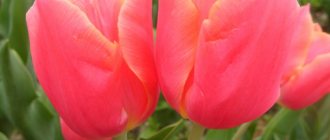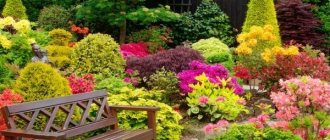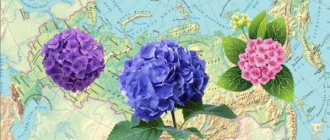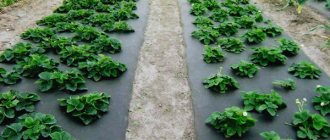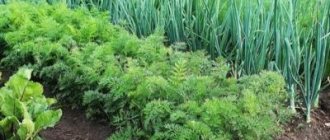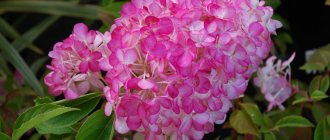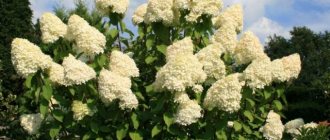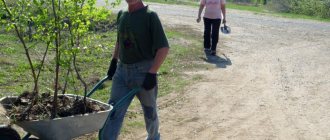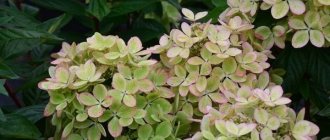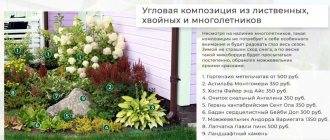Beautiful hydrangeas! For some it is a dream, for others it is their favorite plants that have taken up residence in their own garden. They are grown in city parks and near multi-storey buildings. Hydrangeas are always great. It is no secret that these luxurious bushes have special requirements; plants located nearby must not only be compatible in appearance, but also grow well in acidic soil. No matter what complex composition you have in mind, huge hats of flowers will remain its center.
Popular varieties of hydrangea
In Japan, where hydrangea came to Europe, the flower is considered a gift from heaven and is still grown in temples. There the flower is called audzisai. In the territories of the western continents, the flower has several names: scientific - Hydrangea, meaning a vessel of water, and two romantic ones.
Large-leaved hydrangea bushes next to the garden plot
For your information! At first, naturalist Commerson intended to name a flowering shrub found on the island of Mauritius in the Indian Ocean, unfamiliar to Europeans, Poivrie in honor of his beloved. But then the opinion of the powers that be intervened and the flower received the name of another beauty - Princess of the Holy Roman Empire Hortensia.
Under natural conditions in Asian countries, about 70 species of audzisai grow. It was there that the first Western botanical travelers paid attention to the beautiful bushes and saw what hydrangea combines with in an eastern garden. In the European climate, Hydrangea arborescens (tree-like), Hydrangea paniculata (paniculata), Hydrangea macrophylla (large-leaved), Hydrangea petiolaris (petiolate or climbing), Hydrangea quercifolia (oak-leaved) are popular.
Hydrangea paniculata variety Pinky Winky
What are the benefits of hydrangeas?
Hydrangea (Hydrangea - “water vessel”) is a large-leaved and large-flowered ornamental shrub, loved by gardeners all over the world. It came to Europe from East Asia in the mid-19th century and is widespread in North and Latin America.
The plant is primarily valued for its abundant and incredibly beautiful flowering. But this is not his only advantage.
- Hydrangeas bloom later than other shrubs, usually in July, and bloom until October. They fill that period of summer when spring plants have already faded, and autumn ones have not yet arrived.
- It is often called a chameleon, as the petals tend to change color throughout the season. For example, milky-white inflorescences gradually turn pink, then turn blue, and in the fall they decorate the bush with bronze caps.
- The plant is resistant to bad weather - the inflorescences do not get wet from rain, at most they droop under the weight of moisture.
- There are modern varieties that grow very quickly, increasing the vegetative mass several times over the season. With their help, the area will quickly become decorative.
- Differs in a variety of shades.
In the climate of the Kaliningrad region, such types of hydrangea as paniculate, tree-like, large-leaved, and petiolate hydrangeas thrive. They are represented by a considerable number of varieties.
The color of hydrangea depends not only on the variety, but also on the acidity of the soil - the more acidic it is, the more blue there is in the flower’s palette.
When to plant gladioli in open ground in the spring of 2021, proper care and other secrets
What plants does hydrangea go with?
Designers love to use audjisai in group plantings. Various shapes and colors of inflorescences allow you to use plants in decorating any area. A special feature of some species of hydrangea is their ability to change the color of flowers. Depending on changes in soil acidity and the amount of microelements in it, plants transform. Flowers of different shades bloom on one bush.
Flowerbed with hydrangea - bush planting scheme
Shrubs of the Annabelle variety are especially responsive to watering with special solutions containing aluminum sulfate. The spherical inflorescences will turn from white to pink-lilac after adding 40 g of aluminum-potassium alum dissolved in 10 liters of water to the soil.
Note! Among the Aujisai, there are also chameleon varieties, the flowers of which change color during the flowering season.
Chameleon hydrangea Shloss Wackerbarth
The solution to the question of which plants the hydrangea is combined with will depend on how the bushes look. The neighborhood with thujas will be harmonious. Juniper and hydrangea planted next to each other will successfully complement each other. The combination of blossoming irises and spirea against the background of hydrangea will decorate the front garden. For such a composition you will need an area of about 4 m².
Important! To make the flower ensemble picturesque, several bushes are used simultaneously.
Large-leaved hydrangea in landscape design
The presented type of hydrangea is characterized by large inflorescences. They can come in different shades, but the most common colors are pink, blue and purple. It can grow up to 2 m in height. In addition, it is highly resistant to low temperatures, but requires certain measures. Basically, for the winter season, hydrangea is transplanted into a large pot and placed in a cool place with a temperature no higher than 7 degrees. This allows her to maintain an attractive appearance. The flowering period begins in August and lasts until frost.
One of the most popular varieties of large-leaved hydrangea can rightfully be called “Early Blue”. Its inflorescences are lush, voluminous and look very beautiful.
What to plant next to tree hydrangea
To add individuality to a suburban home, group plantings of a variety of plants are created. Ideas about what kind of neighbors hydrangeas need in the garden are made after analyzing the amount of free space, soil composition, lighting conditions and watering possibilities. After all, drought-resistant perennials will not be suited to the proximity of moisture-loving bushes.
Astilbe - what to plant next to
Various leafy shrubs can be grown next to tree-like hydrangeas. Together they can create a colorful hedge. This species of audjisai is not afraid of partial shade. They look good against the backdrop of grassy flora and next to tall trees. A good environment for her would be clematis, balsams, hosts, lilies, and rose bushes. In combination with cereal herbs they create semi-airy compositions of modern trends.
Note! In partial shade, the shrub forms larger inflorescences than in bright sun.
Нydrangea arborescens (tree-like) in a garden composition
Cultures for decorative compositions with hydrangia
If we reserve the title of queen of the garden for roses, then exquisite hydrangeas can deservedly bear the title of garden princesses. It is important to know which plants and their combinations will become a worthy environment for these beauties.
In appearance, hydrangia easily combines with many cultures, but one should remember some of the “whims” of royalty. In particular, they prefer soft, indirect light and acidic soils, which may not be to every potential companion's taste. However, there are plenty of opportunities for creating delightful flower beds with hydrangeas, other shrubs and herbaceous perennials, both flowering and ornamental. Well-chosen partners allow you to get a lot of profits:
- give the site originality and charm, highlight its style;
- highlight the sophisticated beauty of a garden princess;
- complement the color palette of the decorative composition and introduce contrasting textures into it;
- create a neat and effective foreground of the flower garden;
- balance the massiveness of hydrangeas, adding air and delicacy to the composition;
- fill the plant ensemble with bright colors at a time when the hydrangia inflorescences have not yet opened.
Decide which companions to choose for hydrangeas based on your preferences. Some options are suggested below.
What can be planted next to paniculata hydrangea in the garden
Decembrist flower - how to plant and care
Paniculate species, although they require moist soil, do not tolerate stagnant water. They are among those plants that prefer sun rather than partial shade. They love nutritious soil with medium acidity. In the company of evergreen shrubs and deciduous trees, paniculate inflorescences will look like bright rays against the backdrop of swaying clouds.
Woody plants with dark purple and red foliage will make a beautiful background for equally wonderful audjisai. Next to it they grow cherry laurel, yew, large purple hazel, and leather mackerel. Phlox paniculata, delphiniums, and polygonums will look good near the paniculate inflorescences.
Making flower beds
Hydrangeas go well with many things in the garden. For flower beds, low-growing varieties of hydrangea with narrow foliage and inflorescences of different shades are best suited. The design of a flower garden on a personal plot should be planned in advance. What can you plant next to hydrangea? If the garden design is in the English style, you can plant it in a flowerbed with geraniums and various ornamental herbs. On a site designed in a rustic style, when creating a flower bed, watering cans, buckets, and cans in which hydrangea can be planted will be appropriate.
You can also organize planting in a wooden box. Wooden benches and a table, a well, and a gazebo will harmoniously fit into this design. Ferns perfectly complement hydrangea in a flower bed. Stylistically, they are equal partners and can create amazing ensembles, producing the same noble impression with colors and textures.
If we consider flowering crops, plants of light shades are most suitable for hydrangea: astilbes, anemones, unpredictable physiostegia, paniculate phlox. The inflorescences do not have to be white; you can use contrasting, bright colors to achieve the perfect combination. Daylilies, primrose irises and daffodils can all serve as an elegant frame for a luxurious hydrangea bush.
When selecting plants for a garden in which hydrangea plays a dominant role, you should support the general concept of the landscape being created. It is imperative to take into account the timing of flowering so that the site looks great throughout the season. Today, hydrangeas remain fashionable, in demand and irreplaceable, and the variety of varieties allows you to find “your” plant with which you will definitely be able to make friends.
The neighborhood of thuja and hydrangea
The close proximity of thuja and hydrangea will have a beneficial effect on these plants. Planting shrubs against a background of vertical greenery will create a unique and at the same time harmonious composition. Low bushes of thuja occidentalis Globosa will be a good addition to the composition of flowering plants and will create the atmosphere of a Mediterranean garden, the center of which will be the audzisai bush.
Is it possible to plant hydrangea next to conifers?
It is not advisable to plant audzisai very close to coniferous trees. The distance between plants should be at least 1.5 m. Although flowers and trees need approximately the same soil composition, their moisture requirements are different. In addition, the trees have a rather spreading root system, which will not allow hydrangea roots to develop.
For your information! Needles prevent the development of diseases and the appearance of insect pests.
Hydrangea and juniper side by side
Flowering bushes look beautiful next to a green hedge of hawthorn, cotoneaster or juniper. When choosing from these plants what to plant with hydrangea, they most often decide in favor of spreading evergreen species of juniper. The Blue Carpet variety of scaly juniper will not get lost next to the audzisai bushes and will be a wonderful decoration for the facade of the house.
The combination of juniper and hydrangea against the background of the facade of the house
Scent for the whole season
The combinations turned out beautiful, even sophisticated, but there was one drawback that remained to be eliminated. Almost complete absence of aroma. The fragrance of flowers evokes delight and pleasant memories. Three types of plants will help solve the problem. Petunia, the owner of a slightly sourish spicy smell. Just a couple of bushes at the base of the bush will bloom fragrantly all season. Aromatic tobacco has an aroma reminiscent of wild herbs combined with expensive perfume. A particularly bright accent appears on a quiet evening. Numerous stars of flowers on openwork stems will be a good decoration. And of course alyssum, as without it. A ridge along the edge of plantings or along the border of paths will fill the garden with a honey aroma.
What to plant under hydrangea
A delicate palette, coupled with white and pink inflorescences, will be created by:
- snow-white echinacea;
- pink rudbeckia and geranium.
Lilac shades of hydrangeas will decorate:
- purple, pink and blue lupins;
- pale burgundy peonies.
The plants in these compositions will complement each other and create continuously blooming corners. Ground covers thyme, sedum, and aubrieta will cover all the free space on the ground and enhance the tenderness of the flower arrangement.
Note! The bush requires abundant watering throughout the summer, especially if it is dry. Frequent fertilizing with complex fertilizers for flowering shrubs is required.
Composition of different varieties
The idea of planting different varieties of hydrangeas in one flower arrangement is very good. This option is ideal for creating a hedge, as well as for designing a path, artificial pond or recreation area. To make the flower bed as effective and comfortable for plants as possible, you must follow several rules:
- Shrubs should be planted at a distance of 1-1.5 meters from each other. Over time, the hydrangea will grow and require a lot of space.
- When choosing varieties, it is worth considering their frost resistance. Some types of hydrangeas tolerate winters well, others need to be insulated or transplanted into large pots on the veranda during the cold season.
- Solid hydrangea flowers look best together, such as white or pink. If you want to create a composition in a sophisticated style, then you should not mix different shades.
It is worth remembering that this garden crop needs nourishment.
In order for the inflorescences and leaves to be lush and bright, it is necessary to oxidize the soil once every two weeks with aluminum sulfate or the bark of coniferous trees.
What to plant next to hydrangea in the flowerbed
There are many opinions about what hydrangeas are combined with in a garden flower bed. First of all, ferns are chosen as neighbors of hydrangeas. Gardeners love to use variegated hostas with large leaves. These plants highlight the dignity of their neighbors. Low-growing ivy and periwinkle will not be lost against the backdrop of evergreen fern and original hosta, complementing the flowerbed where audzisai reigns. Planted next to them, the mantle will fit into this ensemble with its inflorescences reminiscent of clouds, and will eliminate the possible heaviness characteristic of the bushes.
Is it possible to plant hydrangea next to chrysanthemum?
Late varieties of chrysanthemums blooming in autumn will undoubtedly decorate the flower beds in which hydrangeas are planted. Bush chrysanthemums will not shed flowers and leaves even after the first frost. At this time, dried inflorescences, old diseased shoots, and leaves are already pruned from the bush. And the chrysanthemums growing nearby will replace the former summer splendor of hydrangeas.
An unpretentious bergenia can also be planted next to the bush. At first he will hide at the feet of the bushes. After some time, it will develop its large, fleshy green leaves on thick stems, and then, with the onset of cold weather, it will recolor them in bright red shades.
For your information! In winter, this plant does not die, so the leaves will peek out from under the snow and remind you of the past summer.
Perennials
Hydrangea is very picky; it withers under the rays of the scorching sun, preferring openwork partial shade. This must be taken into account when choosing perennial plants. Usually limited to a mowed lawn or decorative lining around bushes, try filling the space with amazing shade-loving flowers. It is the composition that allows you to give individuality to the site. Strict, prim with a claim to luxury, romantic blooming, retro, rustic - in any of these styles hydrangea will take its place.
Unique hosts are aristocratic; they will add rigor to the design of the site. The delicate tones of large leaves go well with large inflorescences.
Heuchera, astilbe and fern easily get along with shade-loving shrubs. Bright leaves and flowers create the feeling of a fairy garden, every corner of which is shrouded in mystery.
A simple and at the same time surprisingly gentle survivor can take up space at the base of a bush. Apical pachysandra, periwinkle and ivy will also cope well with this role. Ordinary mint, lemon balm, and catnip will add lightness and aroma. The composition will be close to combinations of plants in the wild.
Large bergenia leaves give a sense of grandeur, the composition seems complete. The early flowering of bergenia compensates for the long spring sleep of hydrangea. After the snow melts, shiny green leaves appear, and a little later delicate caps of flowers grow.
Daylilies, lilies, daffodils, irises, crocuses, tulips and anemones will settle under the noble bush for a long time, only emphasizing its beauty. Paniculate phloxes come in many shades and allow you to achieve depth of color.
In the lower tier, lychnis with snow-white or fiery red flower caps is relevant, perennial cornflowers are tender, like first love, and Turkish carnations with all the variety of shades.
Annuals will complement the picture with bright, showy flowers. Purslane, eschscholzia, gazania, ageratum, heliotrope, calceolaria grow well on the sunny side of the plantings and in openwork partial shade. These plants are more suitable for farmhouse-style designs, but some of them can complement sophisticated landscape compositions.
Stockrose or mallow is perhaps the only competitor - its flowering is not inferior in splendor to hydrangea. Single bushes in the foreground will help create volume. Vertical candles change the feeling of space. When selecting a variety, you need to take into account that in this case the rule of contrast applies. If your hydrangea has white flowers, choose a mallow with maroon or scarlet petals. If the hydrangea has blue or pink flowers, plant white mallow. A less bright, but very gentle partner will be the marshmallow. Its bush is thicker and wider, but much lower. It adds calmness to the composition.
Is it possible to plant hydrangeas of different colors next to each other?
Shrubs with different crown shapes, with flowers of different shades and sizes look great next to each other. Such compositions are found very often along fences, paths, and on the banks of artificial reservoirs. Using a variety of fencing, you can divide the garden area into individual zones and create an original composition in each of them. Flowers lend themselves to decorative pruning; they can be used to create unusually shaped front gardens or flower meadows.
Flowering bushes will be appreciated by anyone passing by. There is no doubt that at the first glance at these flowers his mood will immediately lift. The more such beauty there is around, the more often hydrangeas are found in city gardens, parks, and on the streets, the more happy smiles, and therefore the fewer troubles.
Popular varieties for garden decoration
To decorate gardens and parks in Russia, landscape designers use 2 types of hydrangea in their projects: paniculate, tree-like and large-leaved. The first 2 species have gained popularity due to their unpretentiousness and frost resistance. In the middle zone, it is better to choose places that are as sunny as possible for planting them. In the southern regions, it is recommended to provide slight shading for hydrangea. Below is a list of the 10 most famous plant varieties in Russia.
Annabelle
AnabelThe variety belongs to the tree hydrangea. The plant is a shrub that grows up to 1.5 m in height, with a spherical crown with a diameter of 3 m. Large inflorescences are spherical in shape, their diameter ranges from 15 to 25 cm. At the initial stage of development, the flowers have a greenish color; during flowering they become snow-white. Young seedlings require shelter for the winter. Mature plants show good frost resistance, are unpretentious, and not susceptible to disease. Lives up to 50 years.
Vanilla Fraise
A popular representative of paniculate hydrangea. Shrub about 2 m high with a spreading crown. At the beginning of flowering, the petals are snow-white; in the sun they turn pink, gradually acquiring a crimson hue by autumn. The inflorescences are pyramidal in shape and up to 35 cm long, resembling creamy ice cream with strawberry syrup. Begins to bloom in the first year of planting. Excellent frost resistance. Young specimens require mulching for the winter.
Limelight
A two-meter compact bush that does not require garter. Flowers in wide pyramidal inflorescences 30 cm long bloom by August and remain on the plant until frost. The petals gradually change their color from lime to yellow, and then snow-white. In autumn, the flowers take on a pinkish tint and the leaves turn purple. The variety requires fertile soil, has good disease resistance and excellent frost resistance, which increases with age.
Peppermint
A remontant variety belonging to the large-leaved hydrangea species. The flowers have two-color petals with a pink, blue or purple center and a white edge. The brush is folded into the shape of a sphere with a diameter of up to 25 cm. The height of the bush is 0.7-0.9 m. The crown is spherical in shape, compact. The variety requires good lighting. Can be grown in a container.
Pinky Winky
Paniculate hydrangea of Belgian selection. The height of the bush varies from 1.5 to 2.5 m. The crown is wide and spreading. The inflorescences are cone-shaped, snow-white in color, up to 25 cm long. The formation of racemes continues until autumn. Their base turns purple and new white flowers bloom at the tops. Requires garters to support due to particularly large brushes. Before wintering, the inflorescences are cut off so that the shoots do not break off. The winter hardiness of the variety is high.
Polar Bear
One of the best varieties of paniculate hydrangea. The height of the bush is 1.5-2 m, it looks compact. The inflorescences are wide-pyramidal, very large, up to 30-40 cm. The shoots are strong, resistant to drooping. At the initial stage of flowering, the petals are lime-colored, then successively change to white and cream. By the end of summer the flowers turn pink. The variety is easy to grow in any climate. The plant is not prone to disease and recovers quickly. In winter, hydrangea does not require shelter, but does need mulching.
Sterilis
A popular variety of tree hydrangea. The bush grows on average up to 1.5 m. The crown is loose, spherical in shape. Drooping shoots. The inflorescences are corymbose, convex, white. The plant winters well in the middle zone; in the northern regions it requires shelter. Characterized by rapid growth. For more luxuriant flowering, it needs pruning.
White Dome
The variety is a well-known representative of tree hydrangea. The height of the bush is up to 1.5 m. The leaves are large. The inflorescences are a dome-shaped shield with a diameter of up to 25 cm and look delicate. The color of the petals is cream with a white border. The branches are erect and do not require support. The crown diameter is up to 3 m. The plant gives good annual growth and has high winter hardiness. Only young specimens of hydrangea can freeze.
Phantom
A spreading and powerful bush of two meters in height and the same width with vertical shoots. The conical inflorescences, up to 30 cm long, consist of large, creamy flowers. By the beginning of autumn the petals turn pink. The variety is not demanding on soil composition and has good disease resistance. Can be grown as a standard tree. Winter hardiness is excellent. When frozen, the plant quickly recovers and blooms luxuriantly. It is better to plant it in sunny places. Hydrangea Phantom is a real long-liver.
Planting and growing
Most hydrangea varieties require good light to bloom. It is better to choose a place where the plant can receive sun in the morning or evening hours. Midday heat can cause burns on the leaves. Any building or tall neighbors can provide protection from the scorching sun. If hydrangea is used in the landscape, what it is combined with according to the growing conditions should also be taken into account.
Important! Increased light requirements for the Phantom, Endless Samme, and Peppermint varieties.
The soil for these plants should be loose, but at the same time retain water well; sandy loam soil will not suit them. For high-quality flowering, soil fertility is important, so growing hydrangea requires the application of fertilizers. Fertilizers begin to be introduced simultaneously with the beginning of the growing season, alternating organic and mineral.
All nutritional compositions are supplied to the plant in liquid form. Superphosphate and potassium sulfate are used as fertilizing. Nitrogen fertilizers need to be applied only in early spring; later they can enhance the growth of green mass to the detriment of flowering. It is important to give hydrangeas nutrients when the buds form.
Important! Polar Beer, Limelight, White House and Endless Samme are especially demanding on soil fertility.
Most varieties of hydrangea require pruning, which can be done in spring or autumn, since the plant blooms on the shoots of this and last year. For paniculate and tree hydrangeas, pruning in the spring is more suitable, since their inflorescences form on the tops of new shoots. But large-leaved hydrangea is pruned in the fall; in the spring, only frozen and dried shoots are removed.
